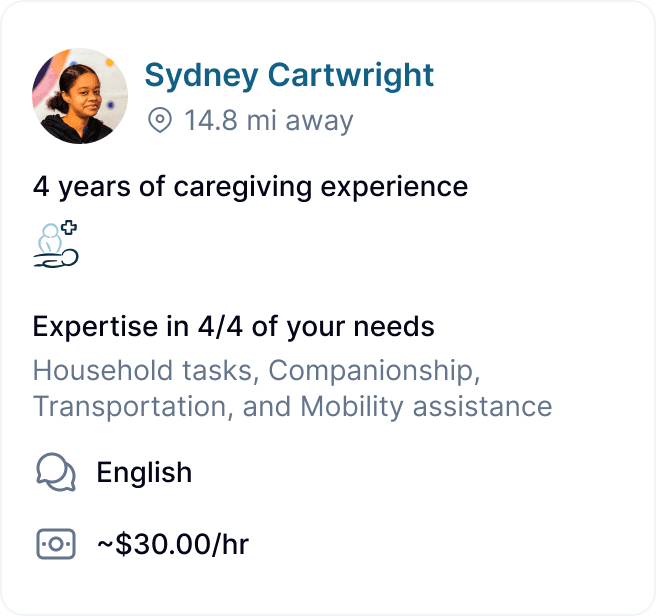Managing Caregiver Expectations and Family Boundaries



Caring for an aging loved one is an act of deep compassion—but it’s also a journey filled with emotional, physical, and logistical challenges. Whether you’re a first-time caregiver or have been supporting a family member for years, managing your own expectations and establishing healthy boundaries with family and friends is crucial for both your well-being and the quality of care you provide.
Let’s explore practical strategies to help you navigate these complex dynamics and build a more sustainable, harmonious caregiving experience.
Why Managing Expectations Matters
It’s natural to want to give your loved one the very best. However, setting unrealistic expectations—of yourself, your family, or even your loved one-can quickly lead to frustration, guilt, and burnout.
Caregiving often comes with unexpected twists: medical setbacks, fluctuating moods, or new care needs that arise overnight. By managing your expectations, you create space for flexibility, resilience, and self-compassion, all of which are vital for a long-term caregiving journey.
Key Benefits of Setting Realistic Expectations:
Reduces stress and anxiety
Prevents feelings of inadequacy or guilt
Fosters better communication and teamwork among family members
Supports a more positive and fulfilling caregiving experience
Assessing Needs and Setting Achievable Goals
Start by honestly assessing your loved one’s needs, abilities, and preferences. Consider their medical condition, level of independence, and daily routines. This will help you set realistic goals for what you can (and cannot) provide on your own—. Remember, it’s perfectly okay to ask for help or seek outside support, including help from professional caregivers, when your limits are reached.
Tips:
Break tasks into manageable steps. Focus on one thing at a time rather than trying to do everything at once.
Celebrate small victories, such as a good day or a successful doctor’s appointment. These moments matter.
Allow for setbacks. Progress in caregiving is rarely linear, so flexibility is key.
The Power of Open Communication
Caregiving is rarely a solo endeavor. Family members, friends, and even neighbors may want to help—or may unintentionally add stress with unsolicited advice or conflicting opinions. Open, honest communication is essential for setting expectations and avoiding misunderstandings.
How to Foster Healthy Communication:
Establish a clear care plan. Work with a range of stakeholders—from family members to doctors to estate planners—to effectively plan for all aspects of your loved one’s care, including their needs, preferences and finances. Laying it all out clearly is a great way to define expectations (and boundaries). See here for more on Care Planning.
Hold regular family meetings to discuss care plans, share updates, and address concerns. This creates a safe space for everyone to be heard and helps align expectations.
Be clear about your own needs and limits. For example, say, “I need some time to recharge on weekends,” instead of, “You need to help more.”
If a family member’s suggestions feel overwhelming, set guidelines for when and how care topics are discussed. Maybe a weekly check-in is more productive than daily calls or drop-ins.
Establishing and Maintaining Boundaries
Boundaries are invisible lines that protect your time, energy, and emotional well-being. In caregiving, boundaries can be especially tricky-after all, you want to be there for your loved one, but you also need to take care of yourself.
Types of Boundaries to Consider:
With Your Loved One: Decide which tasks you’re comfortable handling and which are better delegated to others. For example, you may choose not to assist with bathing or toileting if it feels too intimate or physically risky. Having a plan for when to get help—and with what tasks—can prevent resentment and burnout.
With Family Members: Set limits on when and how care decisions are discussed. If a relative frequently offers advice or drops by unannounced, kindly but firmly communicate your needs. For example, “I appreciate your concern, but I’m not able to discuss care decisions right now. Let’s set up a time to talk later this week.”
With Friends and Neighbors: Unplanned visits can disrupt routines and add stress. Set expectations around visiting hours or ask friends to call ahead. This preserves relationships while respecting your caregiving schedule.
Boundary-Setting Tips:
Be specific and direct. Clearly state what you need and why.
Avoid blaming language. Focus on your needs rather than what others are doing wrong.
Share consequences if boundaries are crossed, and be consistent in enforcing them.
Practice saying “no” without guilt. Healthy boundaries benefit everyone involved.
Finding the Balance: Not Too Rigid, Not Too Flexible
It’s easy to swing between extremes—either doing everything yourself (and burning out) or saying yes to every request (and feeling overwhelmed). The healthiest boundaries exist somewhere in the middle. They allow you to be generous and supportive without sacrificing your own well-being.
Ask Yourself:
Am I comfortable saying “no” when I need to?
Do I accept “no” from others without resentment?
Am I sharing too much or too little about my caregiving experience?
With practice, you’ll learn to adjust your boundaries as circumstances change, creating relationships that feel supportive rather than strained.
Prioritizing Self-Care
You can’t pour from an empty cup. Prioritizing your own health—physically, emotionally, and mentally-makes you a better caregiver in the long run.
Schedule regular breaks, maintain hobbies, and stay connected with friends. If you’re feeling overwhelmed, reach out for support from family, friends, or a facilitator like Clara, who can help connect you with trusted caregivers and resources.
Conclusion: Building a Sustainable Caregiving Journey
Managing caregiver expectations and setting healthy family boundaries isn’t always easy, but it’s essential for a sustainable caregiving journey. By communicating openly, setting realistic goals, and respecting your own limits, you can provide compassionate care without losing yourself in the process.
If you’re ready to explore how Clara’s network of independent caregivers can support your family with professional caregiving, get in touch by completing our quick care survey, calling us at 415-985-0926, or emailing contact@clarahomecare.com to get started.
Remember: You’re not alone on this journey. With the right support and boundaries in place, you can care for your loved one-and yourself—with confidence and compassion.
Caring for an aging loved one is an act of deep compassion—but it’s also a journey filled with emotional, physical, and logistical challenges. Whether you’re a first-time caregiver or have been supporting a family member for years, managing your own expectations and establishing healthy boundaries with family and friends is crucial for both your well-being and the quality of care you provide.
Let’s explore practical strategies to help you navigate these complex dynamics and build a more sustainable, harmonious caregiving experience.
Why Managing Expectations Matters
It’s natural to want to give your loved one the very best. However, setting unrealistic expectations—of yourself, your family, or even your loved one-can quickly lead to frustration, guilt, and burnout.
Caregiving often comes with unexpected twists: medical setbacks, fluctuating moods, or new care needs that arise overnight. By managing your expectations, you create space for flexibility, resilience, and self-compassion, all of which are vital for a long-term caregiving journey.
Key Benefits of Setting Realistic Expectations:
Reduces stress and anxiety
Prevents feelings of inadequacy or guilt
Fosters better communication and teamwork among family members
Supports a more positive and fulfilling caregiving experience
Assessing Needs and Setting Achievable Goals
Start by honestly assessing your loved one’s needs, abilities, and preferences. Consider their medical condition, level of independence, and daily routines. This will help you set realistic goals for what you can (and cannot) provide on your own—. Remember, it’s perfectly okay to ask for help or seek outside support, including help from professional caregivers, when your limits are reached.
Tips:
Break tasks into manageable steps. Focus on one thing at a time rather than trying to do everything at once.
Celebrate small victories, such as a good day or a successful doctor’s appointment. These moments matter.
Allow for setbacks. Progress in caregiving is rarely linear, so flexibility is key.
The Power of Open Communication
Caregiving is rarely a solo endeavor. Family members, friends, and even neighbors may want to help—or may unintentionally add stress with unsolicited advice or conflicting opinions. Open, honest communication is essential for setting expectations and avoiding misunderstandings.
How to Foster Healthy Communication:
Establish a clear care plan. Work with a range of stakeholders—from family members to doctors to estate planners—to effectively plan for all aspects of your loved one’s care, including their needs, preferences and finances. Laying it all out clearly is a great way to define expectations (and boundaries). See here for more on Care Planning.
Hold regular family meetings to discuss care plans, share updates, and address concerns. This creates a safe space for everyone to be heard and helps align expectations.
Be clear about your own needs and limits. For example, say, “I need some time to recharge on weekends,” instead of, “You need to help more.”
If a family member’s suggestions feel overwhelming, set guidelines for when and how care topics are discussed. Maybe a weekly check-in is more productive than daily calls or drop-ins.
Establishing and Maintaining Boundaries
Boundaries are invisible lines that protect your time, energy, and emotional well-being. In caregiving, boundaries can be especially tricky-after all, you want to be there for your loved one, but you also need to take care of yourself.
Types of Boundaries to Consider:
With Your Loved One: Decide which tasks you’re comfortable handling and which are better delegated to others. For example, you may choose not to assist with bathing or toileting if it feels too intimate or physically risky. Having a plan for when to get help—and with what tasks—can prevent resentment and burnout.
With Family Members: Set limits on when and how care decisions are discussed. If a relative frequently offers advice or drops by unannounced, kindly but firmly communicate your needs. For example, “I appreciate your concern, but I’m not able to discuss care decisions right now. Let’s set up a time to talk later this week.”
With Friends and Neighbors: Unplanned visits can disrupt routines and add stress. Set expectations around visiting hours or ask friends to call ahead. This preserves relationships while respecting your caregiving schedule.
Boundary-Setting Tips:
Be specific and direct. Clearly state what you need and why.
Avoid blaming language. Focus on your needs rather than what others are doing wrong.
Share consequences if boundaries are crossed, and be consistent in enforcing them.
Practice saying “no” without guilt. Healthy boundaries benefit everyone involved.
Finding the Balance: Not Too Rigid, Not Too Flexible
It’s easy to swing between extremes—either doing everything yourself (and burning out) or saying yes to every request (and feeling overwhelmed). The healthiest boundaries exist somewhere in the middle. They allow you to be generous and supportive without sacrificing your own well-being.
Ask Yourself:
Am I comfortable saying “no” when I need to?
Do I accept “no” from others without resentment?
Am I sharing too much or too little about my caregiving experience?
With practice, you’ll learn to adjust your boundaries as circumstances change, creating relationships that feel supportive rather than strained.
Prioritizing Self-Care
You can’t pour from an empty cup. Prioritizing your own health—physically, emotionally, and mentally-makes you a better caregiver in the long run.
Schedule regular breaks, maintain hobbies, and stay connected with friends. If you’re feeling overwhelmed, reach out for support from family, friends, or a facilitator like Clara, who can help connect you with trusted caregivers and resources.
Conclusion: Building a Sustainable Caregiving Journey
Managing caregiver expectations and setting healthy family boundaries isn’t always easy, but it’s essential for a sustainable caregiving journey. By communicating openly, setting realistic goals, and respecting your own limits, you can provide compassionate care without losing yourself in the process.
If you’re ready to explore how Clara’s network of independent caregivers can support your family with professional caregiving, get in touch by completing our quick care survey, calling us at 415-985-0926, or emailing contact@clarahomecare.com to get started.
Remember: You’re not alone on this journey. With the right support and boundaries in place, you can care for your loved one-and yourself—with confidence and compassion.
Caring for an aging loved one is an act of deep compassion—but it’s also a journey filled with emotional, physical, and logistical challenges. Whether you’re a first-time caregiver or have been supporting a family member for years, managing your own expectations and establishing healthy boundaries with family and friends is crucial for both your well-being and the quality of care you provide.
Let’s explore practical strategies to help you navigate these complex dynamics and build a more sustainable, harmonious caregiving experience.
Why Managing Expectations Matters
It’s natural to want to give your loved one the very best. However, setting unrealistic expectations—of yourself, your family, or even your loved one-can quickly lead to frustration, guilt, and burnout.
Caregiving often comes with unexpected twists: medical setbacks, fluctuating moods, or new care needs that arise overnight. By managing your expectations, you create space for flexibility, resilience, and self-compassion, all of which are vital for a long-term caregiving journey.
Key Benefits of Setting Realistic Expectations:
Reduces stress and anxiety
Prevents feelings of inadequacy or guilt
Fosters better communication and teamwork among family members
Supports a more positive and fulfilling caregiving experience
Assessing Needs and Setting Achievable Goals
Start by honestly assessing your loved one’s needs, abilities, and preferences. Consider their medical condition, level of independence, and daily routines. This will help you set realistic goals for what you can (and cannot) provide on your own—. Remember, it’s perfectly okay to ask for help or seek outside support, including help from professional caregivers, when your limits are reached.
Tips:
Break tasks into manageable steps. Focus on one thing at a time rather than trying to do everything at once.
Celebrate small victories, such as a good day or a successful doctor’s appointment. These moments matter.
Allow for setbacks. Progress in caregiving is rarely linear, so flexibility is key.
The Power of Open Communication
Caregiving is rarely a solo endeavor. Family members, friends, and even neighbors may want to help—or may unintentionally add stress with unsolicited advice or conflicting opinions. Open, honest communication is essential for setting expectations and avoiding misunderstandings.
How to Foster Healthy Communication:
Establish a clear care plan. Work with a range of stakeholders—from family members to doctors to estate planners—to effectively plan for all aspects of your loved one’s care, including their needs, preferences and finances. Laying it all out clearly is a great way to define expectations (and boundaries). See here for more on Care Planning.
Hold regular family meetings to discuss care plans, share updates, and address concerns. This creates a safe space for everyone to be heard and helps align expectations.
Be clear about your own needs and limits. For example, say, “I need some time to recharge on weekends,” instead of, “You need to help more.”
If a family member’s suggestions feel overwhelming, set guidelines for when and how care topics are discussed. Maybe a weekly check-in is more productive than daily calls or drop-ins.
Establishing and Maintaining Boundaries
Boundaries are invisible lines that protect your time, energy, and emotional well-being. In caregiving, boundaries can be especially tricky-after all, you want to be there for your loved one, but you also need to take care of yourself.
Types of Boundaries to Consider:
With Your Loved One: Decide which tasks you’re comfortable handling and which are better delegated to others. For example, you may choose not to assist with bathing or toileting if it feels too intimate or physically risky. Having a plan for when to get help—and with what tasks—can prevent resentment and burnout.
With Family Members: Set limits on when and how care decisions are discussed. If a relative frequently offers advice or drops by unannounced, kindly but firmly communicate your needs. For example, “I appreciate your concern, but I’m not able to discuss care decisions right now. Let’s set up a time to talk later this week.”
With Friends and Neighbors: Unplanned visits can disrupt routines and add stress. Set expectations around visiting hours or ask friends to call ahead. This preserves relationships while respecting your caregiving schedule.
Boundary-Setting Tips:
Be specific and direct. Clearly state what you need and why.
Avoid blaming language. Focus on your needs rather than what others are doing wrong.
Share consequences if boundaries are crossed, and be consistent in enforcing them.
Practice saying “no” without guilt. Healthy boundaries benefit everyone involved.
Finding the Balance: Not Too Rigid, Not Too Flexible
It’s easy to swing between extremes—either doing everything yourself (and burning out) or saying yes to every request (and feeling overwhelmed). The healthiest boundaries exist somewhere in the middle. They allow you to be generous and supportive without sacrificing your own well-being.
Ask Yourself:
Am I comfortable saying “no” when I need to?
Do I accept “no” from others without resentment?
Am I sharing too much or too little about my caregiving experience?
With practice, you’ll learn to adjust your boundaries as circumstances change, creating relationships that feel supportive rather than strained.
Prioritizing Self-Care
You can’t pour from an empty cup. Prioritizing your own health—physically, emotionally, and mentally-makes you a better caregiver in the long run.
Schedule regular breaks, maintain hobbies, and stay connected with friends. If you’re feeling overwhelmed, reach out for support from family, friends, or a facilitator like Clara, who can help connect you with trusted caregivers and resources.
Conclusion: Building a Sustainable Caregiving Journey
Managing caregiver expectations and setting healthy family boundaries isn’t always easy, but it’s essential for a sustainable caregiving journey. By communicating openly, setting realistic goals, and respecting your own limits, you can provide compassionate care without losing yourself in the process.
If you’re ready to explore how Clara’s network of independent caregivers can support your family with professional caregiving, get in touch by completing our quick care survey, calling us at 415-985-0926, or emailing contact@clarahomecare.com to get started.
Remember: You’re not alone on this journey. With the right support and boundaries in place, you can care for your loved one-and yourself—with confidence and compassion.
More about caring for family
More about caring for family


When Siblings Disagree About Care: Tips for Reaching Consensus



Clara Editorial Team


Smart Home Devices for Aging in Place: What’s Worth the Investment in 2025?



Clara Editorial Team


Aging Parents and Elder Care: A Starter Pack for Care Novices



Lowrie Hilladakis


Can a Family Member Be Paid to Be a Caretaker in California?



Clara Editorial Team


When Is It Time for Assisted Living—or Is In-Home Care the Better Choice?



Clara Editorial Team


Making Tough Choices Easier: The Power of Advance Care Planning



Lowrie Hilladakis


Understanding the Emotional Impact of Caring for Aging Parents



Vanessa Bustos


Balancing Work and Caregiving: Strategies for Busy Families



Vanessa Bustos


Coordinating Long-Distance Care: A Guide to Supporting Loved Ones from Afar



Jon Levinson


Setting Boundaries Without Guilt: A Family Caregiver's Guide



Vanessa Bustos
GEt started for free
Better care starts with Clara.
Find, hire, and pay top-notch caregivers without the headache for a price that fits your budget.



GEt started for free
Better care starts with Clara.
Find, hire, and pay top-notch caregivers without the headache for a price that fits your budget.



GEt started for free
Better care starts with Clara.
Find, hire, and pay top-notch caregivers without the headache for a price that fits your budget.

